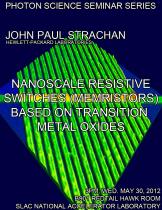Speaker: John Paul Strachan, Hewlett-Packard Laboratories
Program Description
Metal-oxide based crossbar structures (“memristors”) exhibit a strong electrically-driven resistance change and may have applications in memory (ReRAM), computation, sensing, and synaptic (neural) computing. While heavily characterized electrically, an understanding of the physical changes induced during the resistance switching has been limited due to the challenges of observing very subtle material changes occurring in the nanoscale volume between metal contacts. I will describe a set of experiments measuring the electronic, chemical, and structural properties within functioning titanium oxide and tantalum oxide devices with nanoscale spatial resolution using x-ray and electron based spectroscopy and microscopy techniques. We have observed the occurrence of interesting phase changes and shown the key role played by oxygen vacancies which unexpectedly condense into a long-range ordered phase which becomes the focal point for resistance switching. Significant heating is observed to occur in nanoscale volumes during electrical operation, which may further accelerate key electrochemical and ionic processes involved. I will show how this material knowledge has yielded improvements in the devices and also show sub-nanosecond electrical measurements which explore the high speed dynamics and characteristic time-scales for the material changes.





